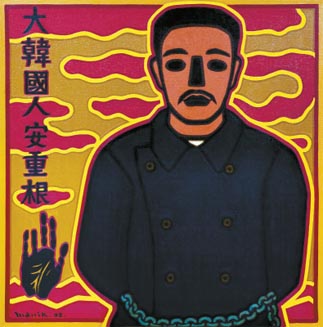A search for Korean identity in one artist’s broad strokes

Lee’s “Great Korean Ahn Jung-geun(2008) Provided by Gallery Hyundai
“Contemporary art is not for humanity but is art for the sake of art,” Lee said. “I tried to put humanism-related themes into my paintings.”
Sixty paintings by Lee will be shown at Gallery Hyundai in southern Seoul beginning tomorrow in an exhibition titled “Worshiping Humanism.” These works include his most recent paintings, produced this year, as well as those created during the 1990s.
Lee’s works show a fascination with literature, religion, history, poetry and mythology, with distinctively Korean roots. His human figures have dark brown skin and wear humble traditional clothes. As a whole, Lee’s oeuvre evokes nostalgia.
The artist said his style was formed in the late 1970s, after he returned from a trip to Paris that began in 1973. Lee says after his voyage to Europe he thought he ought to base his style on Korean emotions rather than simply following Western traditions.
“I painted and erased over and over,” Lee said. “Then, I came across the concept of ‘We Koreans.’ I wanted to include human relationships between me and my family, with family and neighbors, and with my country and its history. There, I wanted to find our identity.
“As I delved into Korean themes, my paintings became more two-dimensional and out of perspective.”
Lee’s paintings were so unique and powerful that some of his works were even used as posters for cultural events. His painting of Queen Myeongseong was used in 1995 as a poster for the local musical “The Last Empress,” which was based on the life story of the Joseon Dynasty (1392-1910) queen who was murdered by Japanese agents in 1895. Another piece was used for the 2007 musical “Dancing Shadow,” which was adapted from the novel “Forest Fire” by Cha Bum-suk about a remote village during the Korean War. These two pieces are also part of the exhibit.
The exhibition continues at Gallery Hyundai Gangnam Space through Dec. 20. Hours are 10 a.m. to 6:30 p.m. Tuesdays to Sundays. Go to Apgujeong Station, line No. 3, exit 2. For details, call (02) 519-0800 or visit www.galleryhyundai.com.
By Limb Jae-un [jbiz91@joongang.co.kr]
JoongAng daily Hot issue
- Police seeking to arrest leaders of striking rail union
- North said to have revalued currency
- Exports and imports hit plus growth last month
- Majority believes Sejong blueprint should be revised
- Grace period for labor rule contemplated
- Drug sales soar for stress-related ills
- Top ‘09 retail topic? SSMs
- Two young prodigies return to Seoul
- Breaking the taboo: Sex education in spotlight
- Kim Yu-na prepares for 3rd Grand Prix title
- Ware4 R U, Romeo?










with the Korea JoongAng Daily
To write comments, please log in to one of the accounts.
Standards Board Policy (0/250자)